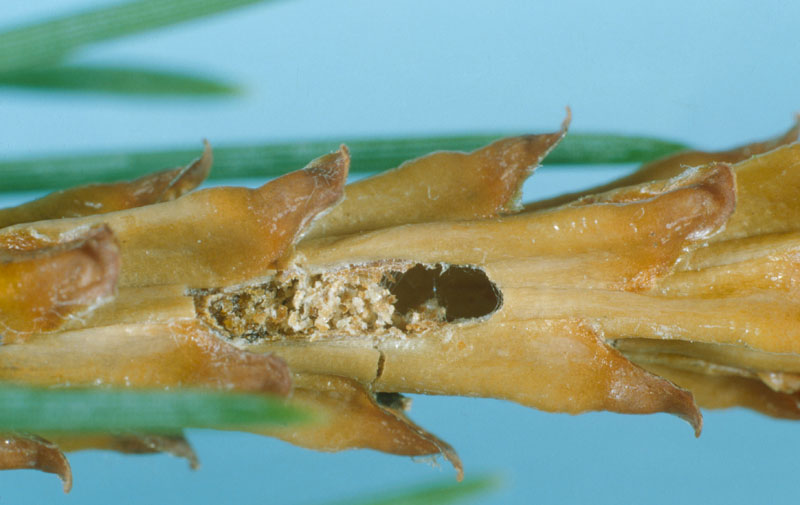This is the fourth part of a series on summer tree insects. This article examines cottonwood leaf beetle, and eastern pineshoot borer.
Introduction
As spring transitions into summer, temperatures gradually rise, and plants enter the next phase of their development. This period coincides with the appearance of numerous insects, many of which infest vulnerable trees and shrubs. When infestations occur, they can be detrimental to plant health. The following discusses some of the insects that commonly infest plants in summer, and how they impact their hosts.
Cottonwood Leaf Beetle (Chrysomela scripta)
Cottonwood leaf beetle is a significant defoliator of aspen, cottonwood, poplar, and willow. The insect is a native pest that occurs throughout the United States. While it seldom impacts forests, it can decimate vulnerable trees in landscape settings. Severe infestations often cause extensive foliar loss. This drastic reduction in foliage inhibits plant growth. Successive defoliations may result in plants becoming structurally unstable, rendering them prone to collapse.
Hosts
Cottonwood leaf beetle infests alder, aspen, cottonwood, poplar, and willow. Throughout the United States, eastern cottonwood is the insect’s preferred host.
Symptoms of Infestation
The egg clusters, larvae, and adults may be observed on infested foliage throughout the growing season. As the larvae feed, they skeletonize the underside of leaves. Brown patches will often form on infested foliage. When the adults feed, they gnaw holes in the leaves, gradually devouring them whole. Only the larger leaf veins are left intact. This causes the leaves to develop a tattered appearance. The persistent feeding of the insects eventually disrupts the tree’s photosynthetic process, inhibiting its growth. Trees that are repeatedly defoliated will often experience extensive foliar dieback. If beetle populations are dense, some trees may succumb to infestation.
Treatment
- Weed management is integral to suppressing cottonwood leaf beetle. Weeds should be removed prior to winter, when the insects are still active.
- Several natural enemies help to reduce cottonwood leaf beetle populations, including the stink bug, Stiretus anchorago, the convergent lady beetle, Hippodamia convergens, and the v-marked lady beetle, Neoharmonica venusta, as well as various ants, spiders, and parasitic wasps. The convergent lady beetle feeds on the eggs, while the stink bug preys on the adults.
- Microbial and chemical insecticides can be employed to eradicate the insects. Insecticides must be applied before the larvae have entered pupation.
- Horticultural oils are effective at smothering the larvae. Applications should be performed in late spring or early summer, when the larvae are most abundant.
Eastern Pineshoot Borer (Eucosma gloriola)
Eastern pineshoot borer, also known as the white pine tip moth, American pine shoot moth, white pine shoot borer, and Tordeuse americaine du pin, is a small moth that infests various conifers. The damage induced by the insect’s feeding can permanently alter the branch architecture of infested trees. While this seldom results in tree mortality, successive infestations can deform tree crowns.
Hosts
Eastern white, red, and Scotch pine are the insect’s preferred hosts. Austrian, jack, mugo, Swiss mountain, and pitch pine, all 2 and 5 needle pines, and white spruce are also commonly infested. Douglas-fir is occasionally infested. Trees that have been weakened by environmental stressors, disease, or other infestations are more prone to infestation. Trees that are 3 to 8 feet tall generally incur the most damage.
Symptoms of Infestation
The damage induced by the larval feeding is seldom severe, but persistent attacks over several years can cause leaders to become stunted or forked. This can result in trees assuming a malformed appearance. In the year following the initial infestation, trees may be devoid of new growth. New shoots that expand will become discolored, eventually turning red. The larval feeding will cause thinner shoots to wilt. In fall and winter, the abandoned shoots will frequently bend or break off at the girdled section, with only short stubs remaining. If the shoots are cut open, they will reveal straight tunnels packed with frass. If opened prior to July, the larvae may be found feeding within the shoots.
Treatment
- To determine if eastern pineshoot borer is present, inspect potential hosts for exit holes in summer.
- Maintain trees through sound cultural practices. Ensure that trees are sufficiently watered, especially during periods of extended drought. Each year, apply a layer of organic mulch around the base of susceptible trees to improve the soil quality, moderate the soil temperature, and retain soil moisture.
- Larvae that bore into small or narrow shoots may chew into the vascular tissue, and be smothered by the ensuing pitch flow.
- Eastern pineshoot borer has several natural parasites that help to reduce its populations. The most effective is the Ichneumon wasp, Glypta sp.
- Insecticides registered for use on eastern pineshoot borer can provide some control when populations are abundant. Applications should be performed in late spring or early summer, before the larvae infiltrate the shoots.
Photo courtesy of the Government of Canada


